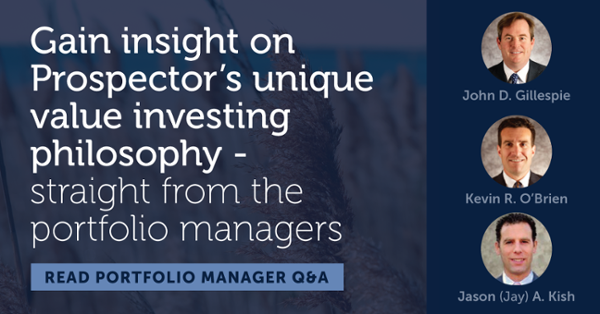 Portfolio Managers John Gillespie, Kevin O’Brien and Jason Kish recently sat down and answered a series of questions regarding the team’s unique value-investing philosophy as well as lessons learned from past experiences.
Portfolio Managers John Gillespie, Kevin O’Brien and Jason Kish recently sat down and answered a series of questions regarding the team’s unique value-investing philosophy as well as lessons learned from past experiences.
Q. Prospector is known for value investing, but with a differentiated approach. What does it mean to look at value from a credit perspective? What inefficiencies are you trying to capture?
John Gillespie: When I describe our equity investing approach as being from a credit perspective, I mean a couple of things: First, it’s in our downside protection mindset which bears similarities to how a high-quality bond manager approaches portfolio management. We continually assess for what can go wrong when seeking risk-adjusted returns as protection of capital is the top priority. We absolutely hate to lose money on any security. A key to outperformance over time is to avoid large losses on any single position. We seek to earn at least $2 of upside for every $1 of downside in each investment, while at the same time, we seek to avoid investments where we determine there is more than 25% downside.
To use a baseball analogy, we try to hit singles and doubles and do not want to risk a strikeout by trying to hit home runs. Overall, Prospector Partners seeks less-financially-leveraged companies with strong underlying franchises and asset values.
Second, it’s our view that the balance sheet is the most important place to start our analysis. Prospector analysts focus on the balance sheet first, cash flow second and income statements last. The balance sheet typically receives less focus by management and is generally more difficult to manipulate, which makes it a reliable place to uncover financial improvement or decay. Prospector then works to convert the balance sheet into a statement of net asset value.
As far as anomalies we endeavor to capture, I would start by restating the key investment techniques we utilize to determine the intrinsic value of a company which are: private market value and free cash flow yield. In most every analysis we perform both of these analyses to determine if Prospector’s view differs from the consensus view which sets the price of the stock at the margin. If differences emerge and we can build sufficient conviction internally on our point of view, we will buy the stock and wait for the market to close the gap.
Explore the 10 other Q&As in the full document. Topics include:
- Why portfolio managers should have their personal assets invested alongside shareholders
- Tips on avoiding Wall Street group think
- How our approach to equities is similar to high-quality bond managers
CLICK HERE TO ACCESS THE FULL Q&A.
If you would like to be notified when we release new insights, please let us know! Just complete the form on this page and we will deliver our content to your inbox once per week.


